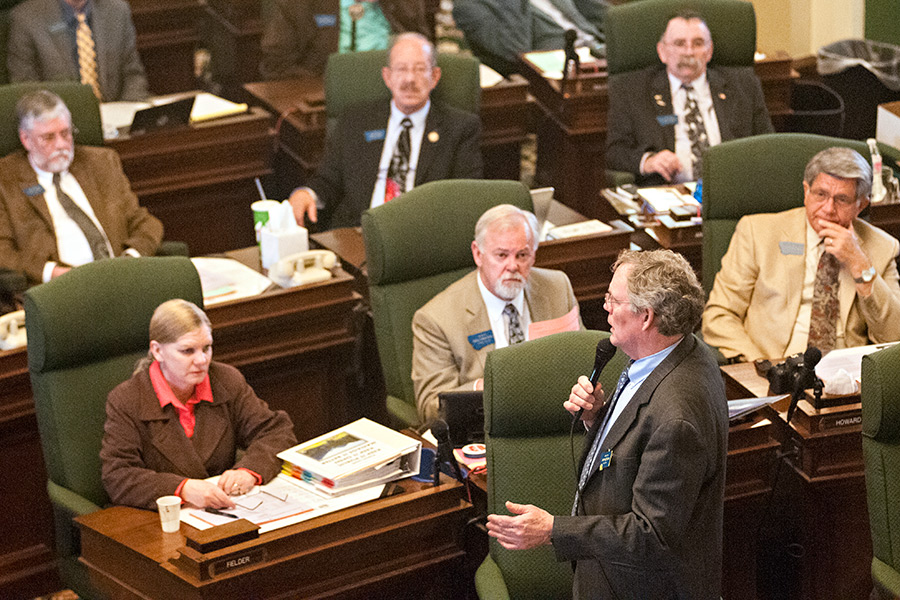Bigfork Senator Seeks Mandatory Studies for Water-Bottling Plants
Sen. Bob Keenan introduces bill that would require environmental impact studies, other rules for proposed bottling facilities
By Molly Priddy
The controversy stemming from a proposed water-bottling plant in Creston has made its way out of the Flathead Valley and to the state Capitol, where lawmakers will discuss a bill that would require automatic, detailed environmental analysis for such projects.
Proposed by Bigfork Republican Sen. Bob Keenan, Senate Bill 215 would require that “large-scale facilities that package water or water-based products for human consumption” would be subject to the Major Facilities Siting Act, which currently regulates pipelines, electric transmission links, pump stations, and other facilities associated with the delivery of energy.
The Montana Legislature put the act into effect in the 1980s to ensure that the state’s environmental resources are protected, the socioeconomic impact of using that resource is considered, citizens have a say in siting such projects, and to establish effective methods for processing the authorizations for these projects.
Keenan said that while it’s not his job to judge the validity of a business endeavor, he believes water-bottling projects should fall under the act’s purview after watching how the Department of Environment Quality and Department of Natural Resources and Conservation have handled the permits from Lew Weaver, the Creston man interested in turning his farmland into the Montana Artesian Water Company.
Weaver applied for a permit with the DNRC that would allow his company to produce up to 140,000 water bottles per hour, 24 hours a day, seven days a week. The water right would allow Weaver’s company to pull 710 acre feet of water annually, equaling roughly 1.2 billion 20-ounce water bottles.
The DNRC issued a preliminary determination to grant the water right permit last January, but that doesn’t mean a right was issued. A group of residents considered to be “valid objectors” opposed the DNRC’s decision, and a hearing is scheduled to discuss those objections with the state on May 23.
Weaver also applied for a permit with DEQ for service water discharge, which would allow Montana Artesian Water Co. to wash out newly formed plastic bottles and then discharge that effluent into a tributary of the Flathead River. DEQ is still making its way through all the comments it received on the project’s draft environmental assessment, and the department may end up recommending an environmental impact study (EIS) on the plant.
But Keenan believes that study should have been conducted from the beginning, and his bill would make such reviews mandatory for water-bottling facilities. Keenan said residents brought the Montana Artesian Water Co. to his attention.
“There was no question that 99.9 percent of my constituents had varying degrees of upset over it,” Keenan said in an interview with the Beacon last week. “For me, it became a problem-solution issue.”
Neighbors to the bottling facility have publicly raised concerns, asking the Flathead County Commission to expand the Egan Slough Zoning District to keep all the land agricultural and then suing the county after the commission rejected the zoning expansion.
Keenan said he believes the most controversial aspect of the proposed plant for many people is the sheer amount of water sought in the permits, as well as the perceived lack of oversight from the state. The DEQ’s environmental assessment of the project left much to be desired, he said.
“That’s why this bill is important,” Keenan said. “Not only would the public scrutiny be enhanced, but also you have to do an EIS, not just a superficial environmental assessment.”
If passed into law, SB 215 would add water-bottling plants to the list of projects requiring a certificate via the process outlined in Montana code. It has many requirements, including an environmental impact study.
SB 215 was scheduled to be heard in the Senate Natural Resources Committee on March 8, and Keenan said he was feeling confident about the bill’s chances. If it becomes law, it would apply retroactively to projects that were not fully permitted as of January 2015, which would include Montana Artesian Water Co.
But Keenan said even if the bill doesn’t put more scrutiny on that particular plant, it would apply to future plants, which are possible given how much water Montana has and how precious drinkable water is. Such major plants are typically built near cities, but rural areas in the country and Canada are seeing more of them.
“We probably could handle this water-bottling plant, but my concern weeks ago (when drafting this bill) was not so much this one as that we’ll end up with four or five of them,” Keenan said.
There could also be an opportunity to tax each water bottle, Keenan said, and have that money go toward fighting aquatic invasive species. He proposed another bill seeking 5 cents per bottle.
For the state senator, the question of regulating water-bottling plants essentially came down to the state Constitution, which says water belongs to the state. Any attempts to remove it and ship it out should be scrutinized, he said.
“You can do what you want within reason on your dirt, but the water flat out and simply belongs to the state of Montana,” Keenan said. “Beneficial use is defined, and it’s mentioned often in statute, but consumptive use is not.”